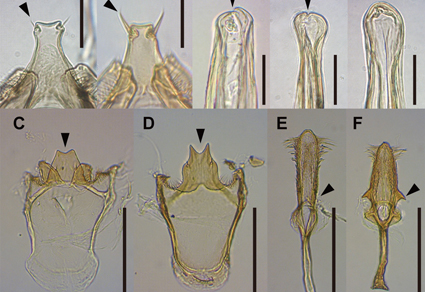Abstract
Cryptic species are often defined as species that cannot be reliably distinguished from some known species due to their morphological similarity. Such species are casually discovered from collections of known species. In the present study, we report the discovery of three cryptic species of the subgenus Sophophora (genus Drosophila) belonging to the montium and melanogaster species groups from laboratory-maintained stocks. Based on our morphological examination, cross experiments, and molecular phylogenetic analyses, the three species were recognized as new to science and described as D. parabicornuta sp. nov., D. xitouensis sp. nov., and D. neolutea sp. nov.
References
- Bock, I.R. & Wheeler, M.R. (1972) The Drosophila melanogaster Species group. University of Texas Publication 7213. University of Texas, Austin, Texas, 102 pp.
- Chen, I.-Z. & Shao, Z. (1988) A new and a newly recorded species of Drosophila (Sophophora) (Diptera, Drosophilidae) from China. Kontyu, 56, 839–842.
- Cumming, J.M. & Wood, D.M. (2017) Adult morphology and terminology. In: Kirk-Spriggs, A.H. & Sinclair, B.J. (Eds.), Manual of Afrotropical Diptera. Vol. 1. Introductory Chapters and Keys to Diptera Families. South African National Biodiversity Institute, Pretoria, pp. 89–133.
- Dobzhansky, T. & Epling, C. (1944) Taxonomy, geographic distribution, and ecology of Drosophila pseudoobscura and its relatives. Carnegie Inst Washington Publication, 554, 47–144.
- Frolova, S.L. & Astaurov, B.L. (1929) Die Chromosomengarnitur als systematisches Merkmal. Zeitschrift für Zellforschung und mikroskopische Anatomie, 10, 201–213. https://doi.org/10.1007/BF02450642
- Hebert, P.D.N., Cywinska, A., Ball, S.L. & deWaard, J.R. (2003) Biological identifications through DNA barcodes. Proceedings of the Royal Society B: Biological Sciences, 270, 313–321. https://doi.org/10.1098/rspb.2002.2218
- Hebert, P.D.N., Penton, E.H., Burns, J.M. & Hallwachs, W. (2004) Ten species in one: DNA barcoding reveals cryptic species in the neotropical skipper butterfly Astraptes fulgerator. The Proceedings of the National Academy of Sciences, 101, 14812–14817. https://doi.org/10.1073/pnas.0406166101
- Kai, H., Zhang, W.-X. & Carson, H.L. (1993) The Drosophilidae (Diptera) of Rainan Island (China). Pacific Science, 47, 319–327.
- Kanturski, M., Lee, Y., Choi, J. & Lee, S. (2018) DNA barcoding and a precise morphological comparison revealed a cryptic species in the Nippolachnus piri complex (Hemiptera: Aphididae: Lachninae). Scientific Reports, 8, 8998. https://doi.org/10.1038/s41598-018-27218-2
- Kimura, M. (1980) A simple method for estimating evolutionary rate of base substitution through comparative studies of nucleotide sequences. Journal of Molecular Evolution, 16, 111–120. https://doi.org/10.1007/BF01731581
- Lancefield, D.E. (1929) A genetic study of crosses of two races or physiological species of Drosophila obscura. Zeitschr f indukt Abstammungs– u Vererbungslehre, 52, 287–317. https://doi.org/10.1007/BF01847272
- McQueen, E.W., Afkhami, M., Atallah, J., Belote, J.M., Gompel, N., Heifetz, Y., Kamimura, Y., Kornhauser, S.C., Masly, J.P., O’Grady, P., Peláez, J., Rebeiz, M., Rice, G., Sánchez-Herrero, E., Nunes, M.D.S., Rampasso, A.S., Schnakenberg, S.L., Siegal, M.L., Takahashi, A., Tanaka, K.M., Turetzek, N., Zelinger, E., Courtier-Orgogozo, V., Toda, M.J., Wolfner, M.F. & Yassin, A. (2022) A standardized nomenclature and atlas of the female terminalia of Drosophila melanogaster. Fly, 16, 128–151. https://doi.org/10.1080/19336934.2022.2058309
- Mo, W.Z., Li, Z.M., Deng, X.M., Chen, A.L., Ritchie, M.G., Yang, D.J., He, Z.B., Toda, M.J. & Wen, S.Y. (2022) Divergence and correlated evolution of male wing spot and courtship display between Drosophila nepalensis and D. trilutea. Insect Science, 29, 1445–1460. https://doi.org/10.1111/1744-7917.12994
- Okada, T. (1966) Diptera from Nepal. Cryptochaetidae, Diastatidae & Drosophilidae. Bulletin of the British Museum (Natural History) Supplement, Entomology, 6, 1–129. https://doi.org/10.5962/p.78200
- Okada, T. (1977) Family Drosophilidae. In: Delfinado, M.D. & Hardy, D.E. (Eds.), A Catalog of Diptera of the Oriental Region. Vol. III-Suborder Cyclorrhapha (excluding Division Aschiza). The University Press of Hawaii, Honolulu, pp. 342–387.
- Rice, G., David, J.R., Kamimura, Y., Masly, J.P., Mcgregor, A.P., Nagy, O., Noselli, S., Nunes, M.D.S., O’Grady, P., Sánchez-Herrero, E., Siegal, M.L., Toda, M.J., Rebeiz, M., Courtier-Orgogozo, V. & Yassin, A. (2019) A standardized nomenclature and atlas of the male terminalia of Drosophila melanogaster. Fly, 13, 51–64. https://doi.org/10.1080/19336934.2019.1653733
- Rice, G.R., David, J.R., Gompel, N., Yassin, A. & Rebeiz, M. (2021) Resolving between novelty and homology in the rapidly evolving phallus of Drosophila. Journal of Experimental Zoology Part B: Molecular and Developmental Evolution (JEZ-B), 340, 182–196. https://doi.org/10.1002/jez.b.23113
- Ruiz-Fiegalan, E.C. (2003) Philippine Drosophilidae (Diptera). I. the subgenus Sophophora of the genus Drosophila with descriptions of the new species. Philippine Entmologist, 17, 1–51.
- Saitou, N. & Nei, M. (1987) The neighbor–joining method: a new method for reconstructing phylogenetic trees. Molecular Biology and Evolution, 4, 406–425.
- Tamura, K., Stecher, G., Peterson, D., Filipski, A. & Kumar, S. (2013) MEGA6: Molecular Evolutionary Genetics Analysis Version 6.0. Molecular Biology and Evolution, 30, 2725–2729. https://doi.org/10.1093/molbev/mst197
- Tan, C.C. (1946) Genetics of sexual isolation between Drosophila pseudoobsccra and Drosophila persimilis. Genetics, 31, 558–573. https://doi.org/10.1093/genetics/31.6.558
- Wang, B.C., Park, J., Watabe, H.A., Gao, J.J., Xiangyu, J.G., Aotsuka, T., Chen, H.W. & Zhang, Y.P. (2006) Molecular phylogeny of the Drosophila virilis section (Diptera: Drosophilidae) based on mitochondrial and nuclear sequences. Molecular Phylogenetics and Evolution, 40, 484–485. https://doi.org/10.1016/j.ympev.2006.03.026
- Wang, R.L. & Hey, J. (1996) The speciation history of Drosophila pseudoobscura and close relatives: inferences from DNA sequence variation at the period locus. Genetics, 144, 1113–1126. https://doi.org/10.1093/genetics/144.3.1113
- Yassin, A., Capy, P., Madi-Ravazzi, L., Ogereau, D. & David, J.R. (2008) DNA barcode discovers two cryptic species and two geographical radiations in the invasive drosophilid Zaprionus indianus. Molecular Ecology Resources, 8, 491–501. https://doi.org/10.1111/j.1471-8286.2007.02020.x
- Yassin, A. (2018) Phylogenetic biogeography and classification of the Drosophila montium species group (Diptera: Drosophilidae). Annales de la Société entomologique de France, New Series, 54, 167–175. https://doi.org/10.1080/00379271.2018.1447853
- Zhang, W.X. & Toda, M.J. (1992) A new species–subgroup of the Drosophila immigrans species–group (Diptera, Drosophi1idae), with description of two new species from China and revision of taxonomic terminology. Japanese Journal of Entomology, 60, 839–850.


